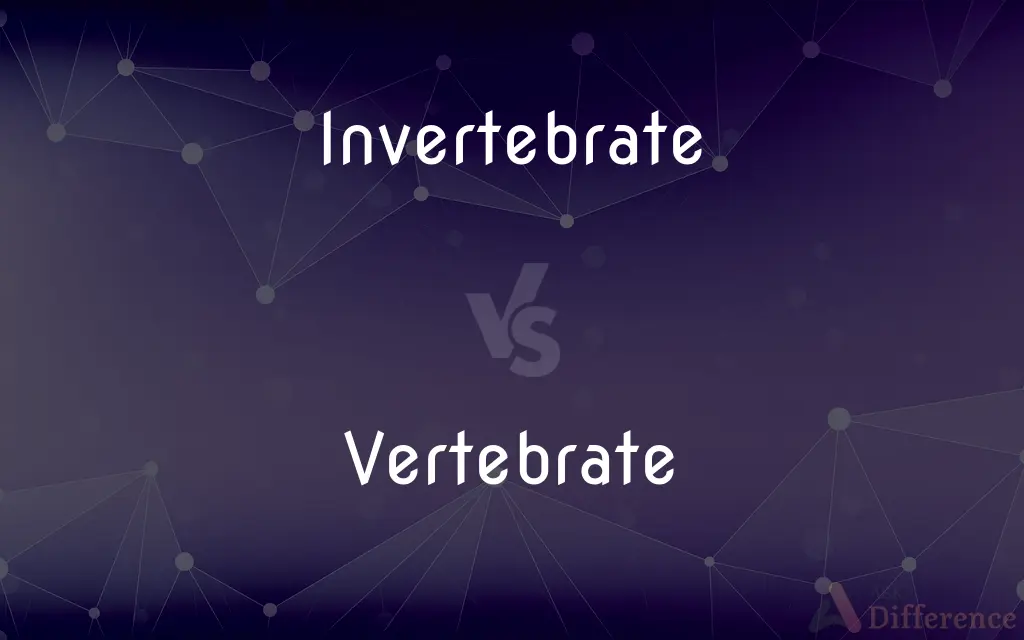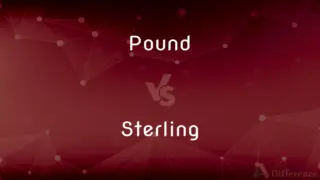Invertebrate vs. Vertebrate — What's the Difference?
By Tayyaba Rehman — Updated on September 22, 2023
Invertebrates are animals without backbones, while Vertebrates possess a backbone or spinal column.

Difference Between Invertebrate and Vertebrate
Table of Contents
ADVERTISEMENT
Key Differences
Invertebrates and Vertebrates represent two major classifications within the animal kingdom, based on the presence or absence of a backbone. Invertebrates encompass a vast range of species that do not have a spinal column. In contrast, Vertebrates are characterized by a well-defined backbone that encloses and protects the spinal cord.
While Invertebrates dominate the animal kingdom in terms of sheer numbers, with species ranging from simple sponges to complex octopuses, Vertebrates include animals like fish, mammals, and birds. The skeletal system of Invertebrates varies widely, from the external exoskeleton of insects to the soft bodies of worms, while Vertebrates have an internal skeletal system made of bone or cartilage.
It's worth noting that while Vertebrates are a smaller group, they are more complex in terms of anatomy and physiology. Invertebrates, on the other hand, show a wider diversity in forms, habitats, and life strategies. From an evolutionary standpoint, Invertebrates appeared earlier in Earth's history, with Vertebrates evolving from certain invertebrate ancestors.
Comparison Chart
Backbone Presence
No backbone or spinal column
Has a backbone or spinal column
Skeletal System
Varies (e.g., external exoskeleton or none)
Internal skeletal system of bone or cartilage
ADVERTISEMENT
Species Diversity
Vast majority of animal species
Smaller group including fish, mammals, birds, etc.
Evolutionary Appearance
Appeared earlier in Earth's history
Evolved from certain invertebrate ancestors
Complexity
Generally simpler structures; diverse forms
More complex anatomy and physiology
Compare with Definitions
Invertebrate
Animals lacking a backbone.
The butterfly is an Invertebrate.
Vertebrate
Animals possessing a spinal column.
Humans are Vertebrates.
Invertebrate
Shows vast diversity in habitats and forms.
Earthworms are Invertebrates that thrive in soil.
Vertebrate
Exhibits advanced physiological functions.
As a Vertebrate, the cat has a sophisticated nervous system.
Invertebrate
Can have external exoskeletons or soft bodies.
The crab's hard shell indicates it's an Invertebrate.
Vertebrate
Includes mammals, fish, birds, reptiles, and amphibians.
Eagles, as birds, fall under Vertebrates.
Invertebrate
Invertebrates are animals that neither possess nor develop a vertebral column (commonly known as a backbone or spine), derived from the notochord. This includes all animals apart from the subphylum Vertebrata.
Vertebrate
Evolved from certain invertebrate ancestors.
Over time, some ancient Invertebrates gave rise to Vertebrate species.
Invertebrate
An animal lacking a backbone, such as an arthropod, mollusc, annelid, coelenterate, etc. The invertebrates constitute an artificial division of the animal kingdom, comprising 95 per cent of animal species and about thirty different phyla.
Vertebrate
Vertebrates () comprise all species of animals within the subphylum Vertebrata () (chordates with backbones). Vertebrates represent the overwhelming majority of the phylum Chordata, with currently about 69,963 species described.
Invertebrate
Denoting an invertebrate or relating to the invertebrates as a group.
Vertebrate
Having a backbone or spinal column.
Invertebrate
Lacking a backbone or spinal column; not vertebrate.
Vertebrate
Of or characteristic of vertebrates or a vertebrate.
Invertebrate
Of or relating to invertebrates
Invertebrate zoology.
Vertebrate
Any of numerous chordate animals of the subphylum Vertebrata, characterized by a segmented spinal column and a distinct well-differentiated head. The vertebrates include the fishes, amphibians, reptiles, birds, and mammals.
Invertebrate
An animal, such as an insect or mollusk, that lacks a backbone or spinal column.
Vertebrate
Having a backbone.
Invertebrate
An animal without vertebrae, i.e. backbone.
Vertebrate
An animal having a backbone.
Invertebrate
(informal) A spineless person; a coward.
Vertebrate
One of the Vertebrata.
Invertebrate
Lacking a backbone; without vertebrae.
Vertebrate
Having a backbone, or vertebral column, containing the spinal marrow, as man, quadrupeds, birds, amphibia, and fishes.
Invertebrate
Cowardly, uncourageous; lacking character.
Vertebrate
Contracted at intervals, so as to resemble the spine in animals.
Invertebrate
Destitute of a backbone; having no vertebræ; of or pertaining to the Invertebrata.
Vertebrate
Having movable joints resembling vertebræ; - said of the arms of ophiurans.
Invertebrate
Any animal lacking a backbone or notochord; the term is not used as a scientific classification
Vertebrate
Of or pertaining to the Vertebrata; - used only in the form vertebrate.
Invertebrate
Lacking a backbone or spinal column;
Worms are an example of invertebrate animals
Vertebrate
Animals having a bony or cartilaginous skeleton with a segmented spinal column and a large brain enclosed in a skull or cranium
Invertebrate
Represents the majority of animal species.
Snails are a type of Invertebrate.
Vertebrate
Having a backbone or spinal column;
Fishes and amphibians and reptiles and birds and mammals are verbetrate animals
Invertebrate
Evolved before vertebrates.
Jellyfish, as Invertebrates, have ancient origins.
Vertebrate
Has an internal skeletal system.
The dolphin's skeletal structure classifies it as a Vertebrate.
Common Curiosities
Which group is larger, Invertebrates or Vertebrates?
Invertebrates comprise the vast majority of animal species.
Do Vertebrates always have bones?
Most Vertebrates have bones, but some, like sharks, have cartilage instead.
Which came first, Invertebrates or Vertebrates?
Invertebrates appeared earlier in evolutionary history.
What are some examples of Invertebrates?
Examples include spiders, snails, and starfish.
Are all Invertebrates small in size?
No, some Invertebrates, like certain squids, can be quite large.
Share Your Discovery

Previous Comparison
Authority vs. Accountability
Next Comparison
Pound vs. SterlingAuthor Spotlight
Written by
Tayyaba RehmanTayyaba Rehman is a distinguished writer, currently serving as a primary contributor to askdifference.com. As a researcher in semantics and etymology, Tayyaba's passion for the complexity of languages and their distinctions has found a perfect home on the platform. Tayyaba delves into the intricacies of language, distinguishing between commonly confused words and phrases, thereby providing clarity for readers worldwide.
















































